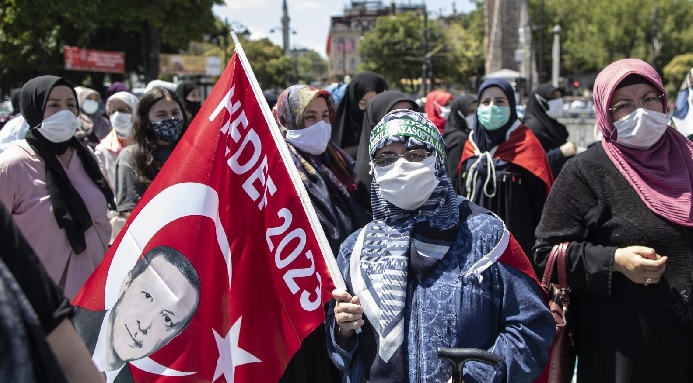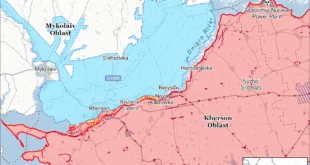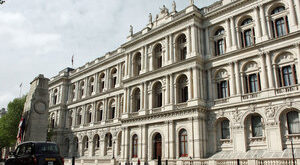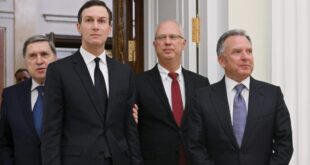
The re-designation of this iconic building as a mosque was not just a sop to the Turkish President’s Islamist fans – but another blow at the memory of the statesman whose legacy haunts and frustrates him.
Turkish President Recep Tayyip Erdogan held the first Muslim prayers since 1934 in Istanbul’s sixth-century former Byzantine church, Hagia Sophia, on July 24, marking the building’s re-conversion into a mosque.
As recently as March 2019, Turkey’s Islamist leader publicly opposed demands from his supporters to alter the status of this World Heritage Site, which Turkey’s founding father, Mustafa Kemal Atatürk, had transformed into a museum in 1934.
His U-turn on Hagia Sophia results in part from his need for a political stunt to boost his party’s waning popularity. More importantly, it reflects his ongoing struggle with Atatürk’s legacy, which exerts surprising influence despite Erdogan’s consolidation of power, and continues to inspire calls for a more secular and pluralistic democracy.
It is ironic that in a country of 84 million citizens, the biggest obstacle to Erdogan’s Islamist ambitions continues to come from a man who died in 1938. The enduring legacy of Atatürk, the architect of the modern secular Republic of Turkey, has so far proven unbeatable.
So much so that Erdogan, who once insulted Atatürk as a “drunk,” has since then felt the need to pay respects, albeit tactically. The ongoing battle between Turkey’s two longest-serving presidents, separated by more than seven decades, will impact not only on the prospects for secular democracy in Turkey but also in other majority Muslim polities.
For over four decades, first as a youth wing member of an Islamist party in the 1970s, then as the mayor of Istanbul from 1994 to 1998, then as prime minister between 2003 and 2014, and finally as president since then, Erdogan has pursued his dream of dismantling Atatürk’s secular republican legacy.
On the one hand, Erdogan has overseen an ambitious social engineering project, using all instruments of the state, namely the 140,000-strong Directorate of Religious Affairs, compulsory religious education in schools, and sectarian indoctrination in state-run media, to mould what he has described as a “pious generation.”
On the other hand, he has worked meticulously to erase Atatürk’s legacy, whether it is secular reforms or institutions. Erdogan has gone so far as to tear down dozens of public structures around the country, from stadiums to airports, that monumentalized Atatürk’s name.
By 2015, Erdogan’s increasing consolidation of power emboldened one of his lawmakers to declare the end of a “90-year commercial break with the 600-year [Ottoman] empire.” This was a reference to Turkey’s republican era as an interval in the Ottoman caliphate that Erdogan would presumably restore.
To the president’s disappointment, however, under his rule, the young have grown less religious and more anti-government, inflicting an embarrassing defeat on him in the 2019 municipal elections. Atatürk’s secular legacy has proven more resilient than the Islamists expected.
The transformation of Hagia Sophia into a museum in 1934 was one of the cornerstones of Atatürk’s cognitive revolution. Ottoman Sultan Mehmet II had converted what was then the world’s greatest church into a mosque after his conquest of Constantinople in 1453, as a symbol of Muslim domination of his empire.
By reversing this highly symbolic act and by turning Hagia Sophia into a museum for all citizens to cherish, regardless of their faith, Atatürk challenged the sectarian hierarchies of the Ottoman era. It was also a gesture of peace and goodwill not only toward neighbouring Greece but also to other Christian nations that the Ottomans had fought for centuries.
Atatürk’s project of building a secular nation state from the ashes of a multi-ethnic and multi-religious empire was far from perfect. Although the principles of equal citizenship and secularism were enshrined in the constitution, ethnic and religious exclusion continued to haunt minorities.
A skewed understanding of secularism ended up guaranteeing neither freedom for nor from religion to the full extent. The Directorate of Religious Affairs, an institution devised to keep religion under government control, evolved into a sectarian instrument for not only disciplining the Sunni majority but also for dominating minorities.
For all its shortcomings, the republican modernization project set into motion colossal transformations that opened Turkey up to new ideas and practices, laying the groundwork for a robust multiparty democracy.
Despite holding its first free and fair democratic elections only in 1950 and being repeatedly haunted by coups carried out by a tutelary military that felt entitled to hold the reins, Turkey’s citizens have time and again found ways to reimpose their democratic will and take back their country. Although voters have frequently looked the other way when elected leaders trampled on fundamental rights and freedoms, particularly of the opposition and of minorities, they have continued to cherish the ballot box as the sole source of legitimacy.
Erdogan’s rise to power, despite all the challenges Turkey’s hardline secularist generals and judges hurled his way, owes much to the legacy of the parliamentary democracy that secular republican reforms set into motion.
However, the same tradition of the ballot box has since become an obstacle to his ambitions to redesign Turkey in accordance with his Islamist ambitions. The more the President’s desire to set the country on a new course meets the electorate’s pushback, the more daring some of his die-hard supporters have become.
Shortly after Hagia Sophia’s conversion into a mosque, an Islamist weekly owned by a pro-government media group called for the reinstatement of the caliphate abolished in 1924 by none other than Atatürk – reinforcing the pro-secular opposition’s accusations about Erdogan’s hidden agenda.
Although a spokesperson for the ruling Justice and Development Party, AKP, was quick to deny plans to change the regime’s “democratic and secular” qualities, many saw this as one of the next steps Erdogan is poised to take, when he feels the time is right – just like his patient strategy to convert Hagia Sophia, more than 17 years into his rule.
Despite the dismal state of the Turkish economy and the waning popularity of the government, it is difficult to predict how the ongoing clash between Turkey’s pro- and anti-secular blocs will end. Although Erdogan has failed to erase Atatürk’s legacy, that legacy alone has not sufficed to articulate and build an inclusive and pluralist alternative in which all citizens, regardless of their ethnicity, faith, class, gender and sexual orientation, feel at home. This was also evident in the fact that many who despise Erdogan’s Islamist designs for Turkey and the Middle East failed to articulate what was wrong from legal, political, and moral perspectives with his conversion of the Hagia Sophia into a mosque.
Atatürk himself was keenly aware that he could not offer a golden age for future republicans to emulate. He warned shortly before his death: “I am leaving no sermon, no dogma, nor am I leaving as my legacy any commandment that is frozen in time or cast in stone.”
Although, from left to the right, many Turkish politicians have attempted to legitimize their positions by tracing them to the dictates of a so-called golden age, the true legacy of Atatürk has been to empower the subjects of an oppressive empire so that they can dare to challenge and hold accountable their rulers as equal citizens. This is one legacy that will prove to be the most resilient to Erdogan’s sectarian project – and has the potential to reverse his supremacist policies in future.
 Eurasia Press & News
Eurasia Press & News



